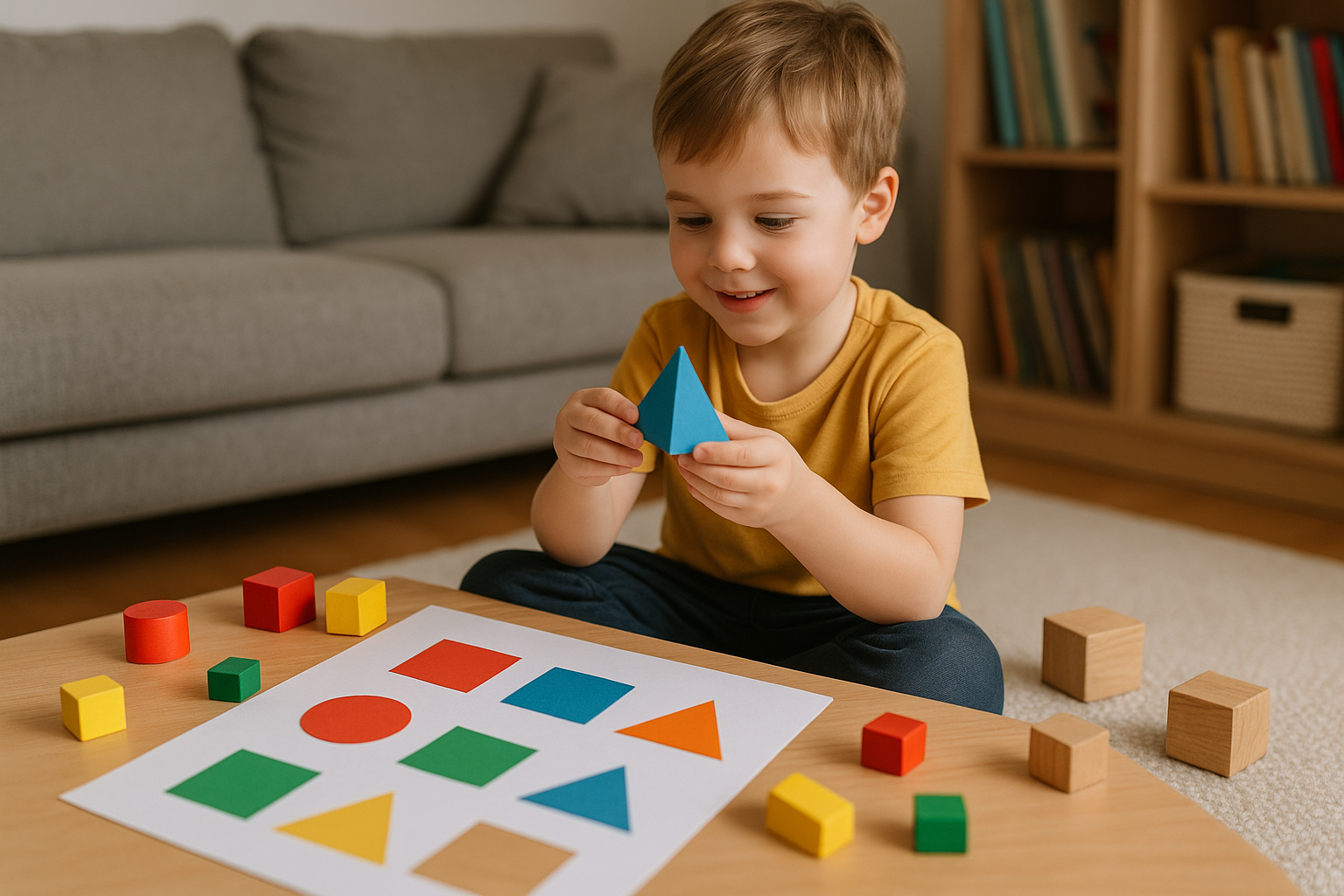Geometry might sound like a subject reserved for older students, but its foundations are built during early childhood through play, exploration, and hands-on activities. From recognizing shapes to understanding spatial relationships, children aged 2 to 6 can begin learning geometry naturally—and joyfully—right at home. In this article, we’ll show you how to teach geometry to young learners using everyday objects, movement, and creative games.
Why Geometry in Early Childhood Matters
Geometry is more than memorizing shapes. It builds:
- Spatial awareness: Understanding how objects relate in space
- Visual discrimination: Recognizing similarities and differences
- Fine and gross motor skills: Manipulating shapes and arranging patterns
- Math readiness: Laying the foundation for measurement and problem-solving
When kids play with shapes, they’re preparing for more advanced math without even realizing it.
Start with the Basics: 2D Shapes
Key Shapes to Learn:
- Circle
- Square
- Triangle
- Rectangle
- Oval
- Star
- Heart
- Diamond (rhombus)
Start with three shapes and expand as your child becomes confident.
Activities to Teach 2D Shapes
1. Shape Hunt Around the House
Give your child a shape card (e.g., a circle) and search for matching shapes in the environment:
- Clock (circle)
- Window (rectangle)
- Sandwich (triangle)
- Book (square)
Learning Outcome: Recognizing shapes in real-world settings.
2. Create Shape Collages
Provide cut-out shapes in different colors and sizes. Let your child glue them to create a picture.
- A house with a triangle roof and square base
- A robot made of rectangles and circles
Learning Outcome: Composing complex figures from simple shapes.
3. Play Shape Hopscotch
Draw shapes instead of numbers with chalk on the floor or outside. Call out, “Hop to the triangle!”
Learning Outcome: Gross motor coordination + shape identification.
4. DIY Shape Puzzle
Cut shapes out of cardboard and create matching outlines on a board or paper. Let your child fit the pieces.
Learning Outcome: Spatial matching and fine motor control.
5. Make Shapes with Playdough
Use playdough to roll and form shapes. For older kids, add toothpicks to create 2D and 3D figures.
Learning Outcome: Tactile shape recognition and geometry vocabulary.
Introduce 3D Shapes
Once 2D shapes are familiar, introduce basic 3D shapes like:
- Sphere
- Cube
- Cylinder
- Cone
- Rectangular prism
Use Real Objects:
- Ball = sphere
- Can = cylinder
- Tissue box = rectangular prism
- Dice = cube
- Ice cream cone = cone
Place objects in a “shape basket” and sort them by type.
Storytime with Shapes
Choose books that introduce geometry concepts:
- Shapes, Shapes, Shapes by Tana Hoban
- Round is a Mooncake by Roseanne Thong
- Mouse Shapes by Ellen Stoll Walsh
After reading, ask questions:
- “What shapes did you see?”
- “Can we find those in our house?”
Reading makes learning personal and engaging.
Geometry Through Building Play
Building toys are excellent geometry tools.
Use:
- Wooden blocks
- LEGO bricks
- Magnetic tiles
- Cardboard boxes
Create buildings, bridges, and towers. Talk about which shapes were used and how they fit together.
Bonus Skill: Engineering and early architecture principles.
Pattern and Symmetry Play
Geometry also involves patterns and balance.
1. Pattern Blocks
Use colored shapes to create repeating sequences:
- Triangle, square, triangle, square…
- Red, blue, red, blue…
Learning Outcome: Visual sequencing and prediction.
2. Symmetry Art
Fold paper and paint one side. When opened, it reveals a symmetrical design.
Learning Outcome: Understanding balance and mirror images.
Spatial Language Games
Introduce terms like:
- Above / below
- Beside / between
- Inside / outside
- Near / far
- Left / right
Use stuffed animals or toys to act out commands:
- “Put the bear under the table.”
- “Place the car beside the truck.”
This boosts comprehension and direction-following skills.
Shape Songs and Rhymes
Music helps with memory and engagement. Try:
- “The Shape Song Swingalong”
- “Shape Up!” by Jack Hartmann
- “I Am a Circle” (simple preschool songs)
Add hand motions or draw as you sing.
Sensory Bin Geometry
Fill a bin with:
- Colored rice or beans
- Shape buttons or foam cutouts
- Scoops and small cups
Ask your child to sort, count, or match shapes.
This is great for toddlers who love tactile learning.
Use Everyday Moments
- Cut sandwiches into triangles or squares
- Talk about the shape of road signs while driving
- Notice shapes in artwork or decorations
- Fold clothes into rectangles while helping with laundry
Geometry is all around us—it just takes a mindful parent to point it out.
Build a “Shape of the Week” Routine
Each week, focus on one shape:
- Display it on the fridge
- Do one art activity featuring that shape
- Go on a scavenger hunt for it
- Create a mini book about it
This keeps learning focused and fun without being overwhelming.
Wrapping Up: Making Geometry Child’s Play
Teaching geometry at home doesn’t require worksheets or textbooks. With simple materials and a bit of creativity, you can help your child build a strong understanding of shapes, space, and structure. By keeping it playful and relevant, you’ll spark a love for learning that goes far beyond math.
